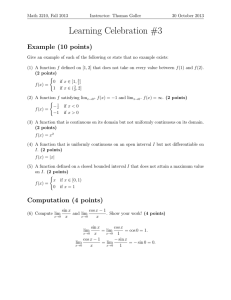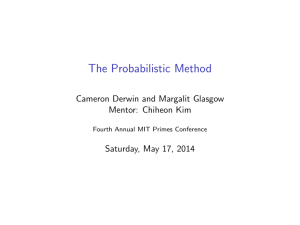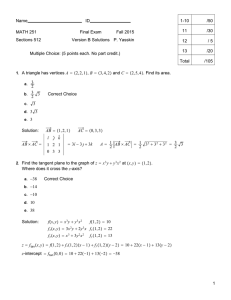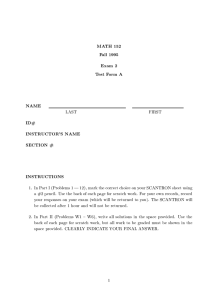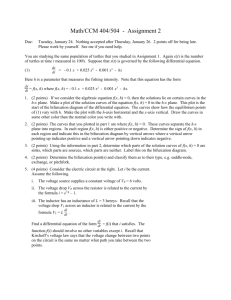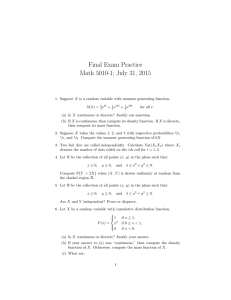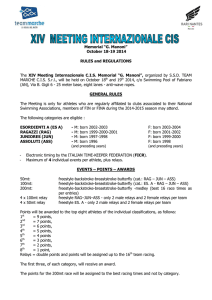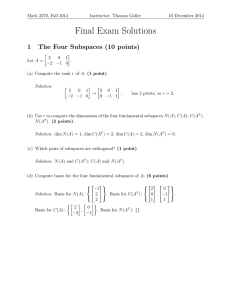;
advertisement
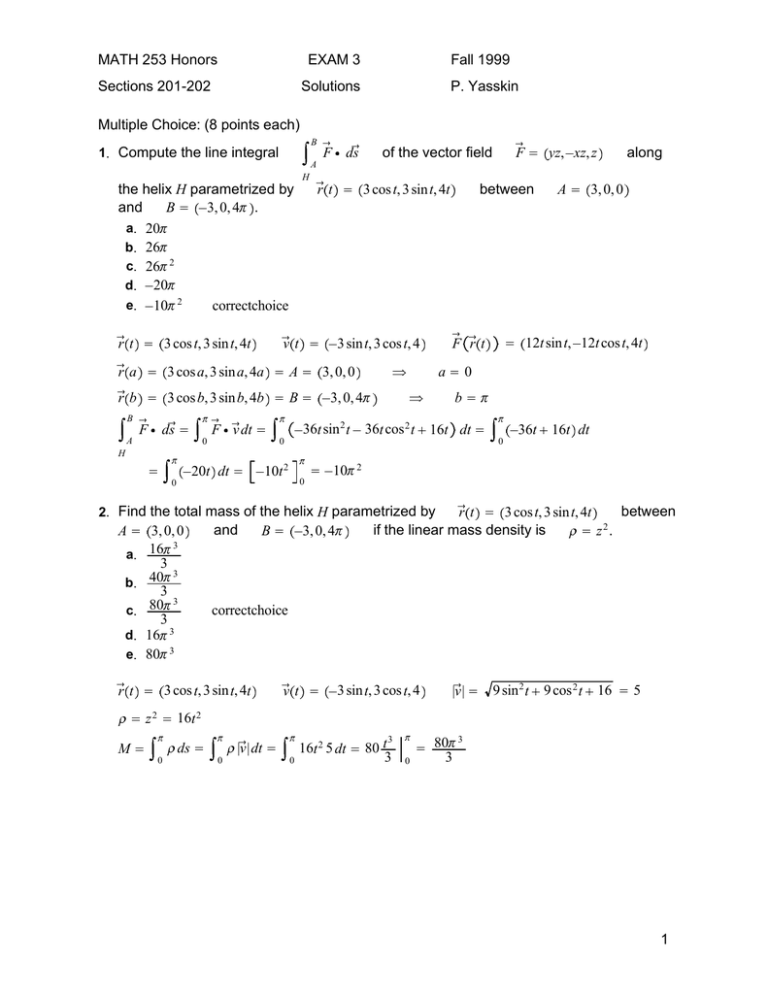
MATH 253 Honors EXAM 3 Fall 1999 Sections 201-202 Solutions P. Yasskin Multiple Choice: (8 points each) B ds ; F 1. Compute the line integral yz, "xz, z F of the vector field A H the helix H parametrized by and B "3, 0, 4= . a. 20= b. 26= c. 26= 2 d. "20= e. "10= 2 correctchoice rt 3 cos t, 3 sin t, 4t rt 3 cos t, 3 sin t, 4t vt "3 sin t, 3 cos t, 4 ra 3 cos a, 3 sin a, 4a A 3, 0, 0 rt F A 3, 0, 0 12t sin t, "12t cos t, 4t a0 ® rb 3 cos b, 3 sin b, 4b B "3, 0, 4= between along b= ® B ds ; = F v dt ; = "36t sin 2 t " 36t cos 2 t 16t dt ; = "36t 16t dt ; F A 0 0 H 0 = = 0 0 ; "20t dt "10t 2 "10= 2 rt 3 cos t, 3 sin t, 4t between 2. Find the total mass of the helix H parametrized by 2 and if the linear mass density is A 3, 0, 0 B "3, 0, 4= >z . 3 a. 16= b. c. d. e. 3 40= 3 3 80= 3 3 16= 3 80= 3 correctchoice rt 3 cos t, 3 sin t, 4t vt "3 sin t, 3 cos t, 4 |v| 9 sin 2 t 9 cos 2 t 16 5 > z 2 16t 2 = = = 3 M ; > ds ; > |v|dt ; 16t 2 5 dt 80 t 3 0 0 0 = 0 3 80= 3 1 >"xy 2 dx x 2 y dy the triangle whose vertices are Theorem. a. 4 b. 8 c. 16 correctchoice d. 32 e. 64 3. Compute P "xy 2 Q x2y counterclockwise around the complete boundary of 0, 0 , 2, 4 and 0, 4 . HINT: Use Green’s x Q " y P 2xy " "2xy 4xy >"xy 2 dx x 2 y dy >Pdx Q dy ;; x Q " y Pdx dy 2 4 2 4 0 2x 0 y2x ; ; 4xy dy dx ; 2xy 2 2 dx ; 2x16 " 2x4x 2 dx 4 3 2 0 1 2 2 0 0 ; 32x " 8x 3 dx 16x 2 " 2x 4 64 " 32 32 0 along the ;yz dx xz dy xy dz rt e sin 4t , cos 5t, ln 1 =t curve between t 0 and t =. scalar potential for F yz, xz, xy . correctchoice a. " ln 2 b. 1 " ln 2 c. "1 " ln 2 d. 1 ln 2 e. "1 ln 2 1 2 4. Compute HINT: Find a A r0 e sin 0 , cos 0, ln1 1, 1, 0 B r= e sin 4= , cos 5=, ln 1 = = 1, "1, ln 2 f yz, xz, xy F The scalar potential is f xyz since By the Fundamental Theorem of Calculus for Curves: B ds ;yz dx xz dy xy dz ; F A f ds fB " fA 1 "1 ln 2 " 1 1 0 " ln 2 ; B A 2 5. (25 points) Stokes’ Theorem states that if S is a surface in 3-space and S is its boundary curve traversed counterclockwise as seen from the tip of the normal to S then F dS > F ds ;; S S Verify Stokes’ Theorem if F y, "x, x 2 y 2 and S is the cone z x 2 y 2 for z t 2 with normal pointing up and in. The cone may be parametrized by: r, 2 r cos 2, r sin 2, r R ;; 5a. (16 points) Compute F dS using the following steps: S i F j k x y z i2y " 0 " j2x " 0 k"1 " 1 2y, "2x, "2 y "x x 2 y 2 r cos 2, sin 2, 1 R 2 "r sin 2, r cos 2, 0 R r R 2 i"r cos 2 " jr sin 2 k r cos 2 2 r sin 2 2 R N "r cos 2, "r sin 2, r This is oriented correctly as up and in. F ;; S r, 2 R 2r sin 2, "2r cos 2, "2 F F dS ;; N dr d2 ; ;"2r 2 sin 2 cos 2 2r 2 sin 2 cos 2 " 2r dr d2 2= 2 2 0 0 0 ; ; "2r dr d2 2= "r 2 "8= and S is the 5b (9 points) Recall F y, "x, x 2 y 2 2 2 cone z x y with normal pointing up and in. Compute using the following steps: > F ds S (Remember to check the orientation of the curve.) r2 2 cos 2, 2 sin 2, 2 v2 "2 sin 2, 2 cos 2, 0 r2 2 sin 2, "2 cos 2, 4 F ds ; 2= F v d2 ; 2= "4 sin 2 2 " 4 cos 2 2 d2 ; 2= "4 d2 "8= > F 0 0 0 S 3 6. (25 points) Gauss’ Theorem states that if V is a solid region and V is its boundary surface with outward normal then F dS dV ;; F ;;; V V Verify Gauss’ Theorem if F xz, yz, x 2 y 2 and V is the solid hemisphere 0tzt 4 " x2 " y2 . Notice that V consists of two parts: z the hemisphere H: 4 " x2 " y2 x 2 y 2 t 4 with z 0 and a disk D: F dV. ;;; 6a. (5 pts) Compute V F 2z 2> cos I 2 F dV ; =/2 ; 2= ; 2 2> cos I > 2 sin I d> d2 dI 2= sin I ;;; 2 0 0 0 V 6b. (8 pts) Compute dS. ;; F =/2 0 2> 4 4 2 8= 0 (HINT: You parametrize the disk.) D r, 2 r cos 2, r sin 2, 0 R r cos 2, sin 2, 0 R 2 "r sin 2, r cos 2, 0 R 0, 0, r N R r, 2 F This is upward. Reverse it: 0, 0, "r N xz, yz, x 2 y 2 0, 0, r 2 dS ;; F N dr d2 ; 2= ; 2 "r 3 dr d2 "2= r 4 ;; F 4 0 0 D D 6c. (9 pts) Compute dS ;; F 2 "8= 0 over the hemisphere parametrized by H I, 2 2 sin I cos 2, 2 sin I sin 2, 2 cos I R I 2 cos I cos 2, 2 cos I sin 2, "2 sin I R 2 "2 sin I sin 2, 2 sin I cos 2, 0 R i 4 sin 2 I cos 2 " j "4 sin 2 I sin 2 k 4 sin I cos I cos 2 2 sin 2 2 N 4 sin 2 I cos 2, 4 sin 2 I sin 2, 4 sin I cos I This is outward. R I, 2 F xz, yz, x 2 y 2 4 sin I cos I cos 2, 4 sin I cos I sin 2, 4 sin 2 I N 16 sin 3 I cos I cos 2 2 16 sin 3 I cos I sin 2 2 16 sin 3 I cos I 32 sin 3 I cos I F dS ; ;; F H 2= 0 ; =/2 0 32 sin 3 I cos I dI d2 2= 32 sin 4 I 4 =/2 16= 0 4 6d. (3 pts) Combine dS ;; F and H dS. ;; F to obtain dS. ;; F V D Be sure to discuss the orientations of the surfaces (here or above) and give a formula before you plug in numbers. D so it points H points up. We reversed N The normals must point outward. N downward. dS ;; F dS ;; F dS 16= " 8= 8= ;; F V 7. H which agrees with (6a). D (20 points) The paraboloid at the right is the graph of the equation z 4x 2 4y 2 . It may be parametrized as r, 2 r cos 2, r sin 2, 4r 2 . R Find the area of the paraboloid for z t 16. r cos 2, sin 2, 8r R 2 "r sin 2, r cos 2, 0 R i"8r 2 cos 2 " j8r 2 sin 2 k r cos 2 2 r sin 2 2 N N 64r 4 cos 2 2 64r 4 sin 2 2 r 2 "8r 2 cos 2, "8r 2 sin 2, r 64r 4 r 2 r 64r 2 1 3/2 2 dr d2 ; 2= ; 2 r 64r 2 1 dr d2 2= 264r 1 A ;; N 3 128 0 0 2 0 = 257 3/2 " 1 96 5
